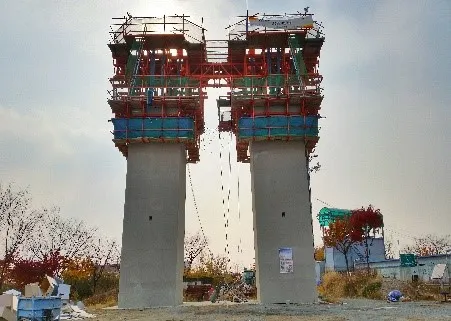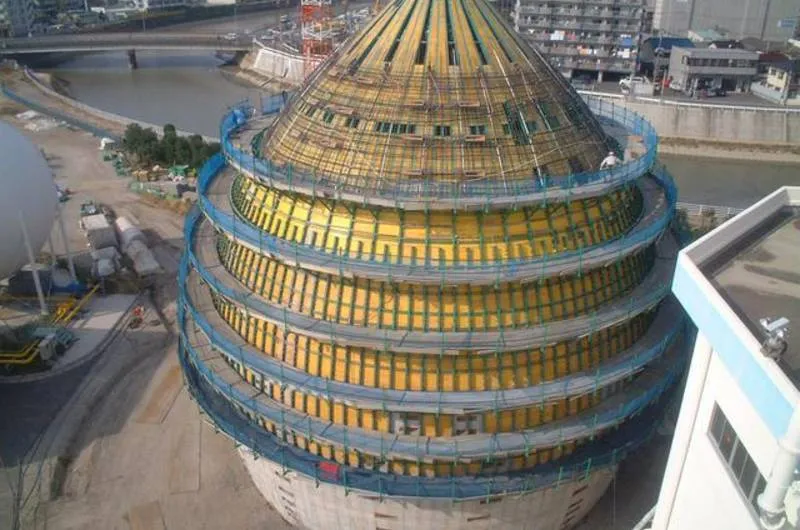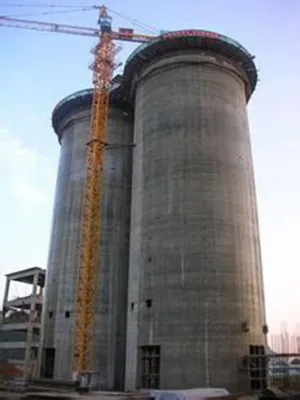Slip form construction involves pouring concrete into the top of a continuously moving formwork. As the concrete is poured, the formwork is raised vertically at a speed that allows the concrete to harden before it is free from the formwork at the bottom. The concrete to be used needs to be workable enough to be placed into the form and consolidated by vibration, yet quick-setting enough to emerge from the form with strength. The concrete must be constantly monitored for its setting rate to ensure the forms are not being raised too fast. It is a self-contained formwork system and can require little crane-time during construction. This is a formwork system that can be used to form any regular shape or core. The formwork rises continuously, at a rate of about 300mm per hour, supporting itself on the core and not relying on support or access from other parts of the building or permanent works.
Slipforming enables continuous, non-interrupted, cast-in-place “flawless” (i.e. no joints) concrete structures that have superior performance characteristics to piecewise construction using discrete form elements. Slip forming relies on the quick-setting properties of concrete and requires a balance between quick-setting capacity and workability. Concrete needs to be workable enough to be placed into the form and consolidated (via vibration), yet quick-setting enough to emerge from the form with strength. This strength is needed because the freshly set concrete must not only permit the form to “slip” by the concrete without disturbing it, but also support the pressure of the new concrete as well as resist collapse caused by the vibration of the compaction machinery.

Different types of slip formwork
There are six types of slip formwork according to the direction of work.
- Vertical slip forming the concrete form may be surrounded by a platform on which workers stand, placing steel reinforcing rods into the concrete and ensuring a smooth pour. Together, the concrete form and working platform are raised utilizing hydraulic jacks.
- Horizontal slip forming for pavement and traffic separation walls concrete is laid down, vibrated, worked, and settled in place while the form itself slowly moves ahead.
- Tapered slip forming is also used in the construction of conical chimneys, cooling towers, piers and other tall concrete structures involving constant or changing thicknesses in walls, diameters and/or shapes. A form is used with sections that overlap so that one gradually slides over the other. This is commonly done in chimney construction but it is not satisfactory for architectural concrete because the lap shows. While the tapered slip-forming process is similar to that used on the standard slip-forming, it requires greater attention, contractor experience and expertise to ensure the success of such projects.
- The Cantilever forming is used as climbers that are independent of cranes and attached to a large area of formwork at storey height. In this system, shuttering has already been completed, which is part of the structure between individual levels of climbers. The cantilever jump form system gives maximum protection, providing a complete self-climbing formwork system that is independent of cranes for walls, columns, supports and floor beers.
- Egg-shaped slip forming is based on the jump form principle that can be adapted to any geometric shape. Individual curvature adjustment can be obtained by adjusting the axis and vertical circumferential slope. The system can be adjusted independently on each side of the wall as well as products of optimal working condition.
- Conical slip forming is a system by which it is possible to construct structures of varying wall thicknesses and tapering walls. The conical formwork is made up of cantilever plates and overlapping plates, which are fastened to steel yoke frames.

Different components of slip formwork
- Wales: It holds vertical forms in place. It also supports various platforms and scaffolds.
- Yokes: It transmits the lifting forces from the jacks to the wales and resists the lateral force of plastic concrete within the form.
- Jacks: It mounts on the jack rod and provides the necessary force to lift the entire slip form system. They serve as a work area for placing and finishing
- Jack rods: These are climbed up by Jacks.

Advantages of slip formwork construction
- Slip forming can achieve high production rates, however, once continuous concreting has begun there is little flexibility for change and so very careful planning is required.
- Only minimal scaffolding and temporary works are required allowing the construction site to be less congested, and so safer.
- The exposed concrete can be finished at the bottom of the rising formwork.
- There is flexibility in that tapering structures with wall reductions can be achieved.
- A major cost of concrete structure construction is the required formwork to retain the concrete till it can be safely de-shuttered and be able to support itself and other imposed loads.
- The formwork needs to be continually removed to newer locations and then re-erected.
- In the case of slip form building, the formwork is erected only once and remains intact until the entire structure is completed.
- The reduction in the movement of formwork and workers also leads to far more safe working conditions that also make it a major advantage.

Application of slip form construction
Slip forming is used for tall structures ( bridges, towers, buildings, and dams), as well as horizontal structures, such as roadways. Its application areas include-
- Service cores for commercial buildings.
- Lift and stair shafts.
- Silos.
- Chimneys.
- Concrete gravity structures
- Bridge pylons and piers.
- Mine headgear towers.
- Shaft linings.
- Surge shafts.
- Liquid containment vessels.
Conclusion
Slip formwork is one of the best techniques which carried out fast and rapid construction in an unusual structure like cooling towers, chimneys, silo and also in roadway construction bridge construction. Slip formwork techniques carried out with more than 16 m height structure and its very rapid and time-saving erection techniques and also economical.
Image Source: patrickparsons.co.uk, kict.re.kr, ulmaconstruction.com, rsb.info, hydequipment.com

